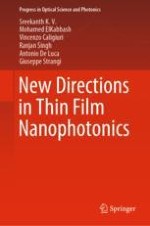This book highlights recent advances in thin-film photonics, particularly as building blocks of metamaterials and metasurfaces. Recent advances in nanophotonics has demonstrated remarkable control over the electromagnetic field by tailoring the optical properties of materials at the subwavelength scale which results in the emergence of metamaterials and metasurfaces. However, most of the proposed platforms require intense lithography which makes them of minor practical relevance. Stacked ultrathin-films of dielectrics, semi-conductors, and metals are introduced as an alternative platform that perform unique or similar functionalities. This book discusses the new era of thin film photonics and its potential applications in perfect and selective light absorption, structural coloring, biosensing, enhanced spontaneous emission, reconfigurable photonic devices and super lensing.
